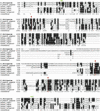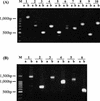Data-mining approaches reveal hidden families of proteases in the genome of malaria parasite
- PMID: 12671001
- PMCID: PMC430172
- DOI: 10.1101/gr.913403
Data-mining approaches reveal hidden families of proteases in the genome of malaria parasite
Abstract
The search for novel antimalarial drug targets is urgent due to the growing resistance of Plasmodium falciparum parasites to available drugs. Proteases are attractive antimalarial targets because of their indispensable roles in parasite infection and development, especially in the processes of host erythrocyte rupture/invasion and hemoglobin degradation. However, to date, only a small number of proteases have been identified and characterized in Plasmodium species. Using an extensive sequence similarity search, we have identified 92 putative proteases in the P. falciparum genome. A set of putative proteases including calpain, metacaspase, and signal peptidase I have been implicated to be central mediators for essential parasitic activity and distantly related to the vertebrate host. Moreover, of the 92, at least 88 have been demonstrated to code for gene products at the transcriptional levels, based upon the microarray and RT-PCR results, and the publicly available microarray and proteomics data. The present study represents an initial effort to identify a set of expressed, active, and essential proteases as targets for inhibitor-based drug design.
Figures








References
-
- Aravind L., Dixit, V.M., and Koonin, E.V. 1999. The domains of death: Evolution of the apoptosis machinery. Trends Biochem. Sci. 24 47-53. - PubMed
-
- Arthur J.S., Gauthier, S., and Elce, J.S. 1995. Active site residues in m-calpain: Identification by site-directed mutagenesis. FEBS Lett. 368 397-400. - PubMed
-
- Ben Mamoun C., Gluzman, I.Y., Hott, C., MacMillan, S.K., Amarakone, A.S., Anderson, D.L., Carlton, J.M., Dame, J.B., Chakrabarti, D., Martin, R.K., et al. 2001. Coordinated programme of gene expression during asexual intraerythrocytic development of the human malaria parasite Plasmodium falciparum revealed by microarray analysis. Mol. Microbiol. 39 26-36. - PubMed
Publication types
MeSH terms
Substances
Grants and funding
LinkOut - more resources
Full Text Sources
